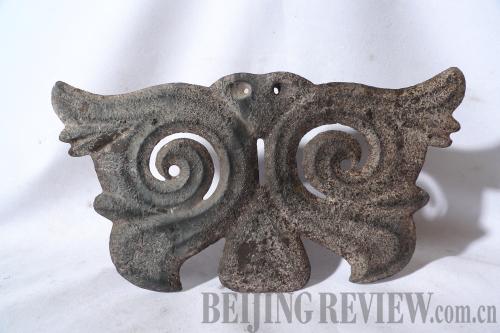|
 |
|
A black-shelled jade pendant (COURTESY OF ZHANG YIPING) |
Approaching the truth
During the following years, Zhang bought up any black-shelled jade sculptures he could lay his hands on, storing these back home where he would meticulously study them with a magnifying glass, hoping to find any possible clue as to their identity.
In his collection, there is a hollowed-out jade badge with a cloud pattern, 300 mm long and only 5 mm thick, as if cut using modern technology. Its edge is as sharp as a blade.
"Even today, it is not easy to sculpt a piece like this," Zhang said, adding that even a jade sculptor he had asked to replicate the badge had said he was unsure of how to proceed, confirming the collector's belief that the piece was indeed ancient.
In time, Zhang additionally managed to discover mysterious symbols dotting his black-shelled collections, which differed from the earliest Chinese inscriptions on bones or tortoise shells of the Shang Dynasty (1,700-1,100 B.C.).
Due to their structure and shape, the collector believes these symbols to be part of a yet unnamed form of writing, a point experts still find hard to support.
"As we know, Shang Dynasty inscriptions belong to the earliest form of Chinese writing. It might well be that these characters are even older," Zhang ventured. "Sadly, archeological research on black-shelled jade sculptures in China is still rudimental. Based on current findings, most of my collection probably dates back to Hongshan Culture, active during the Neolithic Age some 8,000 years ago in north China."
In 1971, archeologists excavated a C-shaped jade sculpture from an ancient tomb in Chifeng, Inner Mongolia Autonomous Region, subsequently found to have a 5,000-year history. Scientists eventually called it the first dragon jade sculpture of ancient Chinese civilization.
Coincidentally, Zhang has collected a number of similar dragon-shaped jade sculptures, confirming his belief that his collections belong to Hongshan Culture.
However, Zhang lacks official archeological support. "This is critical to prove the value of my collections," he said.
"It is unfortunate that national archeological circle does not attach importance to research on Hongshan Culture nor on black-shelled jade sculptures."
There are fewer than 10 collectors of black-shelled jade sculptures in the country at present, the total amount of works including 2,000 pieces. However, a large percentage of these treasures have been taken out of China in recent years, Zhang said.
The collector hopes that the mystery surrounding black-shelled jade sculptures could one day be solved.
"I have spent more than 10 years collecting them. It is worthwhile for me to devote my time to it. Most importantly, I want to find out the truth."
Email us at: baishi@bjreview.com
| 